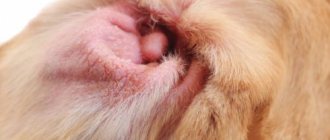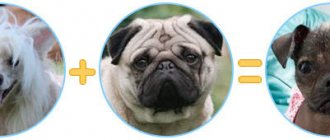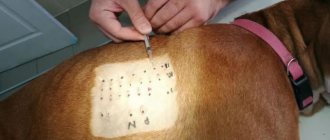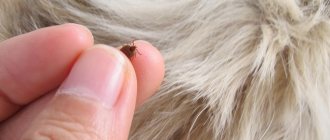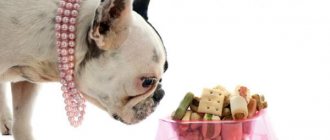Pugs are wonderful pets for the home, capable of becoming true friends for their owners and making friends even with cats.
However, an unpleasant feature of this breed is frequent allergic reactions. Almost every pug owner has encountered this disease. That is why it is so important for owners of dogs of this breed to know what can trigger an allergy in an animal, its symptoms and treatment regimens.
What can pugs be allergic to?
Although pugs are classified as conditionally hypoallergenic breeds, the dogs themselves are predisposed to reactions from the immune system to certain substances. Depending on their route of entry into the body, type and location of localization, several types of allergies are distinguished:
- Food - it is caused by artificial flavors, dyes, synthetic preservatives, chicken, milk, cereals, canned food, yellow fruits and vegetables, chicken eggs.
- Contact – occurs when there is contact with objects (toys, floor coverings, collars, plastic dishes, synthetic upholstery of upholstered furniture) that contain allergens.
- Atopic dermatitis - transmitted to puppies from sick parents, an allergic reaction is caused by poplar fluff, pollen, mites, dandruff, washing powder, bird feathers and mold.
- Bacterial or infectious - the cause is fungi, viruses, microorganisms, bacteria and endoparasites.
- Insect - a reaction to insects that are allergic to the pug - ixodid ticks, fleas, lice eaters, mosquitoes, horse flies, bees, wasps and midges.
- Respiratory - it is caused by household aerosols, perfume, wool and fluff.
- Medicinal or medicinal – from medicinal drugs (analgesics, antibiotics, vitamins, vaccines).
- Autoimmune is an allergic reaction to one’s own cells, which the body recognizes as hostile.
Causes
Despite the fact that thorough research has already been carried out on this topic, the exact causes of acne in dogs have not been established. However, several suspected causes of this disease have been identified. These include:
- Bad ecology.
- Poor quality or incorrectly selected freeze-dried food.
- Mistakes in breeding.
- Inactive lifestyle of animals.
- Hormonal changes that occur between 6 and 10 months of age.
- Improper care of the animal's fur and skin.
Pugs are a breed prone to allergies, a common manifestation of which is acne. Therefore, you should not feed your dog food from your table, and even when selecting professional food, it is advisable to give preference to hypoallergenic food.
How does allergies manifest in pugs?
Allergy symptoms in a pug are not always obvious and appear immediately. The main signs of the pathology include difficulty breathing, coughing, sneezing, wheezing and snoring. Owners often ignore them because their dogs' short muzzles and flat noses cause respiratory problems. The course of allergic rhinitis is aggravated by the anatomical structure of the nasal passages - they are narrower than in representatives of other breeds. Severe itching can be determined by the restless behavior of the pug - he licks the problem area, chews, and itches. Sometimes he scratches himself so much that the skin not only turns red, but also bleeds, and bald spots appear in the places where he scratched. An allergic reaction affects the condition of the eyes - they water, turn red, and the hair around the eye sockets falls out. Ear allergies manifest as persistent infections, inflammation, and foul odor. Other symptoms include:
- thinning fur;
- gastrointestinal disorder;
- ulcers on the skin, peeling, redness;
- dandruff;
- swelling.
Symptoms
Allergies in pugs can be characterized by various clinical symptoms, but a caring owner will always be able to note a general deterioration in the pet’s condition.
An allergy in an animal can be suspected if:
- The dog experiences severe, long-lasting itching.
- The skin begins to peel off (dandruff appears).
- The mucous membranes of the eyes become inflamed.
- Many small ulcers can be seen on the abdomen, chest and armpits.
- Discharge appears from the pet's eyes and nose.
- The dog's behavior changes, it becomes lethargic and inactive.
- An unpleasant odor appears.
- Allergies may be accompanied by coughing and sneezing.
- Problems arise in the digestive system (vomiting, diarrhea, etc.).
Important! If your pet develops the symptoms listed above, you should immediately consult a veterinarian.
Diagnostics
Since the external manifestation of allergies is similar to the clinical picture of lichen, dermatitis, rhinitis, eczema, identifying it and making a diagnosis is quite difficult. If you suspect an allergic reaction in pugs, you should contact a veterinarian who will examine the medical history and prescribe tests:
- to detect internal and external parasites;
- trichoscopy;
- bacteriological culture;
- clinical blood test;
- feces and urine;
- skin scrapings;
- allergy tests.
First, the diagnosis is confirmed or refuted, and then the allergen is determined by exclusion. Most often, the cause of an allergic reaction is pug food or skin and internal parasites.
Dog behavior with atopic dermatitis
When a waxy, spotting discharge, redness, or unpleasant odor appears on the ears, the dog rubs its ears with its paws or scratches them on surrounding objects.
The animal itches, licks its sides, groin, stomach, elbows when redness with crusts or scabs appears. When areas of baldness, brown in color, appear in those places that the dog constantly licks, it itches on the sides and stomach. In this case, there is redness of the skin on the muzzle from constant friction with furniture.
The animal bites and licks the paw pads and the paws themselves. In this case, the limbs have redness, inflammation with an unpleasant odor, and the fur turns brown from regular licking.
How to treat your pet?
At the first signs of pathology, you should consult a doctor, since it is quite difficult to cure allergies and it will take a lot of time to get rid of its unpleasant manifestations. Most often, the treatment regimen includes drugs:
- Antihistamines (Tavegil, Suprastin, Zyrtec) - to quickly relieve swelling and itching.
- Sorbents (Sorbex, activated carbon, Enterosgel) - for rapid removal from the body of substances that cause an allergic reaction.
- Antibiotics, antiviral and antifungal agents - for treating affected areas of the skin.
- Hormonal drugs (Aldecin, Nasonex, Advantan) - to relieve inflammation and reduce immunoglobulin levels.
Antihistamines, which are “first aid” for pugs with allergies, can be given in the form that is most convenient. For allergies they are given drops, tablets or an injection solution. The main task during the treatment period is to identify substances that pugs are allergic to and eliminate contact with them. This can be done by a veterinarian by conducting laboratory tests.
Additionally, it is necessary to treat pugs against fleas and ticks, regularly ventilate and do wet cleaning in the apartment. In the food form of pathology, special attention is paid to the pet’s diet.
In the ears
In some cases, an allergy in a pug can manifest itself in the form of severe itching in the ears. Most often this is due to a reaction to fleas and ticks, which can penetrate very deeply into the dog's ears.
If you cannot remove them yourself using ear sticks, seek help from a doctor.
Ignoring such symptoms can lead to the death of the animal. Important! The main symptom of ear allergies is the appearance of many small pimples.
The following can cause ear allergies in pugs:
- Food;
- hygiene products;
- medicines and vitamins;
- insect bites.
If suspected allergens are excluded and the symptoms do not disappear, otitis may be suspected. This diagnosis is more likely if the following symptoms are added to the itching:
- heat;
- purulent discharge from the ears;
- soreness and swelling of the ear.
To minimize the risk of serious complications, treatment should begin as early as possible. Incorrectly chosen treatment can lead to complete deafness of the dog, so at the first signs of illness, take your dog to the doctor.
What to feed an allergic pug?
If you have a food allergy, you need to exclude foods that cause the reaction from your diet. Most often it is provoked by:
- poultry meat;
- soy;
- Fish and seafood;
- egg yolks;
- bakery;
- sweets;
- semolina and wheat porridge.
It is difficult to understand what product should not be fed to pug cubs. First, all of the above and new foods recently introduced are excluded from the diet. Then gradually add one at a time and observe the dog’s reaction. When characteristic symptoms appear, we can assume that the allergen has been found and is excluded from the pet’s menu. Perhaps he is not alone, so the selection of hypoallergenic food for pugs with allergies needs to be continued.
The main “culprits” of food allergies
The main cause of true food allergies in dogs and cats are proteins, and their mass should be more than 10 kDa; the heavier the protein, the greater the chance that the immune system will “dislike” it. That is why the most common culprits in the development of allergies in dogs are the proteins of beef, dairy products, chicken and wheat gluten, and in cats: milk, beef, fish and chicken. This doesn't mean your dog can't develop a food allergy to, say, turkey, but it's much less likely to happen. There is a lot of good research in humane medicine about what factors predispose people to developing food allergies. For example, the role of dysbiosis and concomitant inflammatory bowel diseases has been proven. There are practically no such studies in dogs, but it is clear that dogs that have had parvovirus gastroenteritis are more susceptible to developing food allergies in the future. So, what foods are the most common for dogs to develop food allergies? (research data for 2022):
- Beef
- Dairy (even fermented milk) products
- Chicken
- Wheat (less often other grains) gluten
Hypoallergenic food for pugs
The best solution when choosing hypoallergenic food for pugs is to purchase industrial food. It is produced using special technology, without the addition of dyes, grains, and allergenic meats. Instead, minerals, prebiotics, herbal products, and vitamins are used. The most balanced and meeting the requirements include the products of manufacturers:
- Bosch - produced in Germany, the main components include lamb meat and rice, price - 650 rubles per kg.
- Biofood - similar composition, price - 400 rubles per kg.
- Acana - two-thirds consists of meat (duck, lamb, pork) or sea fish and one-third of fiber, price per kg - 700 rubles.
- Royal Canin - contains animal fats, hydrolyzed soy protein isolate, rice, cost 1 kg - about 600 rubles
For pugs with allergies, foods from Hills, Pro Plan Purina, Brit and Eukanuba, FarminaVL, Hills are suitable.
Before choosing a specific brand, it is worth consulting with a veterinarian, who recommends feeding the dog based on the tests performed. The food should not only be hypoallergenic, but also affordable for purchase and availability in the store.
Signs of acne
Often, acne in pugs appears against the background of seborrhea - a disease in which increased secretion of sebum occurs, due to which the pores become clogged and pimples or acne appear on the dog's face, and less often on the back of its body. This can happen to any dog, but short-haired breeds that have skin folds on the face are especially prone to acne. And, of course, pugs are also at risk.
Externally, the disease manifests itself as follows: reddish bumps appear on the dog’s face, on its chin, and sometimes on its lips, resembling papules or pimples in appearance. If a secondary infection develops, for example, if the pug scratches the pimples, then eczema or ulcers may appear in place of the acne. This really bothers the dog, it whines in pain and does not allow the inflamed areas of the skin to be touched.
If the disease is neglected, the acne may become crusty, and the affected skin will become inflamed, rough, and may even change color.
Allergies during pregnancy and lactation
During pregnancy, veterinarians recommend excluding foods that can cause allergies from the diet of pugs and adding minerals (iron, iodine, potassium, copper, sodium, phosphorus) and vitamins (riboflavin, choline, pantheonic acid, B5, pyridoxine, folic acid). If allergies worsen during pregnancy and lactation, follow the usual treatment regimen. At the same time, medications are selected that have a more harmless and gentle composition. It is unacceptable to self-medicate a pug; consult a veterinarian at the first sign of an allergy.
To avoid such problems, breed lovers should choose a puppy, paying attention to the pedigree of its parents. The likelihood that offspring will inherit the disease is extremely high.
What should I do to fix the problem?
Establishing diagnosis
In order for the diagnosis to be made correctly, the pug must be shown to a veterinarian. It is unacceptable to make a diagnosis on your own, since there are many diseases that manifest themselves in almost the same way as acne. The veterinarian will be able to carry out the necessary tests and thereby identify the causative agent of the infection, but this cannot be done at home.
Here is a list of diseases that should be excluded when diagnosing acne:
- Demodectic mange is a non-contagious disease caused by scabies mites. It begins with the formation of papules on the face and baldness, usually accompanied by severe itching.
- Bacterial skin infections.
- Foreign objects stuck in the thickness of the skin and causing inflammation: splinters, cereal seeds, etc.
- Skin irritation caused by allergies or exposure to chemicals.
When diagnosing inflammatory skin diseases, including acne, a scraping is often taken from the surface of the dog’s skin, after examination of which it is usually possible to identify the causative agent of the disease. At the same time, staphylococci are often the culprits of acne, both primary and caused by secondary infection.
Often the cause of acne on a pug's face is a weakened immune system of the animal. In addition, staphylococcus itself can provoke the development of immunodeficiency, which can be unsafe for a dog that literally begins to “catch” any other infection.
Treatment
The method of treating pug acne depends on what exactly caused it. If this is an age-related phenomenon caused by hormonal changes in the body of a growing puppy, then treatment may not be required : it will only be enough to strengthen control over the condition of the skin and more thoroughly wipe the dog’s face after eating. You may have to lubricate the pimples several times with brilliant green or terramycin.
It is also permissible to use disinfectants: iodized alcohol, chlorhexidine, septogel or hydrogen peroxide. They need to wipe the folds in the place where the rashes appeared, and then carefully wipe the animal’s skin dry.
All other medications, such as special ointments or antibiotics, are used only as prescribed by a veterinarian. Giving them to your dog yourself, as well as using human remedies for acne to treat it, is completely unacceptable!
In modern veterinary medicine, there is also a tendency to abandon antibiotics in the treatment of acne in favor of stimulating the animal’s immune system. Some veterinarians prescribe homeopathic medications for this disease, the benefits of which have not been confirmed by scientific research. Most likely, there will be no harm from them, but no one can give a guarantee as to whether these funds will be useful.
Prevention
Like any other disease, acne is easier to prevent than to treat. Moreover, often the cause of primary acne is improper care of the animal.
All pug owners need to remember the following:
- It is necessary to inspect the folds on the pet’s face every day and, at the slightest sign of inflammation, wipe them with a disinfectant such as chlorhexidine.
- From the first days of a pug puppy’s appearance in the house, you need to choose the right food for him and not change it unless absolutely necessary. It is better, of course, to feed your pet hypoallergenic factory-produced food, and the food should be at least premium class.
- If the pug is on natural feeding, then it is necessary to avoid giving the dog foods that can cause allergies. And no spices, exotic fruits and, of course, sweets!
- During a walk and even while at home, you need to carefully ensure that the pug does not sniff anything chemical or collect dirt and dust on its face, which can accumulate deep in the skin folds and cause inflammation and acne.
- After feeding, as well as walks and active games, especially those involving digging, it is necessary to wipe the dog’s face in order to remove all traces of dirt from it.
- It is advisable to abandon plastic bowls in favor of ceramic or glass ones, as plastic can cause skin inflammation.
- It is necessary to wipe the dog's face with special antibacterial agents.
- At the first signs of skin inflammation, use a compress of calendula decoction.
- Use preventive medications.
- Always keep an ointment containing benzoyl peroxide in your medicine cabinet.
You should never squeeze pimples and pustules on your pet's face. They should open on their own, but if the abscess is crushed inside the dog’s skin, this can cause even more severe and extensive inflammation.
What foods should you not give to your pug?
Pugs should not be fed table food - fried, smoked, salty and sweet foods can seriously disrupt their digestion.
The following products are prohibited on the pet menu:
- bony fish;
- liver;
- peas, beans and corn;
- pasta;
- wheat, semolina and corn grits;
- grape;
- any citrus fruits;
- confectionery products, including chocolate.
In most cases, the pet’s body accepts boiled eggs well, but they must be introduced into the diet with caution, as this can cause an allergic reaction.
When do you need veterinary help?
You should always contact a veterinarian. Even if your dog exhibits some symptoms (redness, itching), it is better to visit a doctor rather than treat the allergy yourself. Often, diagnoses can only be made based on the results of studies (using special equipment) and tests. If you ignore the symptoms, complications may occur.
There are symptoms when you should not hesitate:
- increased body temperature;
- profuse frequent vomiting;
- diarrhea;
- pain when palpating the auricle, leakage of exudative fluid.
In addition, animals often have reactions to medications, vaccinations, vitamins, and flea collars. If you notice that your dog is depressed, his appetite has worsened, or his hearing acuity has decreased, call a doctor or take your pet to a veterinary clinic. Only a specialist can help, since without a confirmed diagnosis it is not recommended to give medications on your own.
Allergy prevention
The health of a pet depends entirely on its owner. To prevent allergies, it is necessary to carefully select food for the dog, prevent helminthic infestations, cleanse the intestines of toxins, take measures to increase the dog’s immunity, use only hypoallergenic products to care for the dog, regularly examine the dog, and prevent tick bites.
Frequent walks in the fresh air, active games, and properly selected feeding will also help strengthen your pet's immunity.
How to choose dog food
Hypoallergenic food should be selected after testing. If you take the product on your own, you may make the situation worse. Take your pet to the vet. The specialist will take a skin scraping and perform a blood test.
After receiving the results, the doctor will give recommendations on the choice of food.
How to choose what to feed your dog?
- Hypoallergenic compounds should be sought only in super-premium and holistic food classes.
- Be sure to take into account the pet’s age, level of activity, and physiological condition.
- Try different foods if one doesn’t suit you and don’t look for variety if the diet is comfortable for your pet.
How to treat atopic dermatitis
After a complete examination of the animal, the veterinarian prescribes therapy. Symptomatic treatment is carried out in the first stages of immunotherapy, but is sometimes prescribed after it if the effect is short-lived. The veterinarian will recommend special shampoos for skin care, as well as medications of different groups. Typically, the following types of medications are prescribed.
Corticosteroids
The drugs act quickly and effectively and relieve a number of inflammations. These are hormonal agents that relieve itching, redness, and allergic swelling. The most popular form of medication is tablets.
Popular drugs from this series successfully solve their problems, but have a number of side effects:
- shortness of breath;
- polyuria;
- drowsiness;
- calcification of the skin.
Corticosteroids are not prescribed during pregnancy.
Antihistamines
These medications block receptors that are associated with histamines and suppress allergic symptoms.
Antibacterial drugs
These drugs are used for an infectious form of the disease or if a secondary infection has occurred. Antibiotics of the following groups are prescribed:
- penicillins;
- cephalosporins;
- carbapenems.
The combined use of antibiotics and topical agents suppresses the symptoms of bacterial pathology in a short time.
Tricyclic antidepressants
These drugs relieve dogs from excessive nervousness.
Treatment methods
Treatment of allergies in dogs is carried out with medication and by eliminating contact with the allergen. Once the veterinarian determines the cause of the disease, he will prescribe treatment. Typically, antihistamines are given to your dog in the form of tablets or injections.
At first, while the allergen has not yet been identified, the dog may be prescribed medications such as Tavegil, Diazolin or Diphenhydramine - these are universal drugs that work for all forms of allergies. Diprazine, as well as anti-inflammatory ointments, cope well with skin itching.
If it comes to anaphylactic shock (and it also happens in dogs), expressed in severe swelling, vomiting, heart palpitations and even loss of consciousness, then it is necessary to immediately call a veterinarian, because in this case, if urgent assistance is not provided in time, the consequences may be severe, even fatal.


